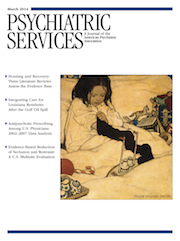Prevalence and Correlates of Suicidal Ideation Among Parolees
Abstract
Objective
This study examined the prevalence and correlates of suicidal ideation among parolees and among persons who were not on parole.
Methods
Three years of data (2009 to 2011) from the National Survey on Drug Use and Health were analyzed. Data on sociodemographic and clinical characteristics and violent behaviors of parolees (N=1,249) and nonparolees (N=114,033) were examined as indicators of need and as predictors of suicidal ideation. Multivariate logistic regression analysis was conducted, using suicidal ideation as the dependent variable.
Results
Over the three years, the average prevalence of suicidal ideation among parolees (8.6%) was more than twice that among nonparolees (3.7%). Characteristics associated with decreased suicidal ideation among nonparolees, such as being married, older, and employed, were not related to lower suicidal ideation among parolees. For parolees, having health insurance decreased the likelihood of suicidal ideation by 50%. Parolees who received a past-year prescription for a mood disorder did not have higher rates of suicidal ideation, although this variable was associated with higher suicidal ideation among nonparolees. Parolees were significantly more likely than nonparolees to rate their health as poor (4.1% versus 2.6%).
Conclusions
Results indicated that parolees have more life stressors and that providing them with access to health care might lower suicidal ideation. Because parolees were more likely to rate their health as poor, providing access to medical care may improve their quality of life and their chance of successful return to the community.



